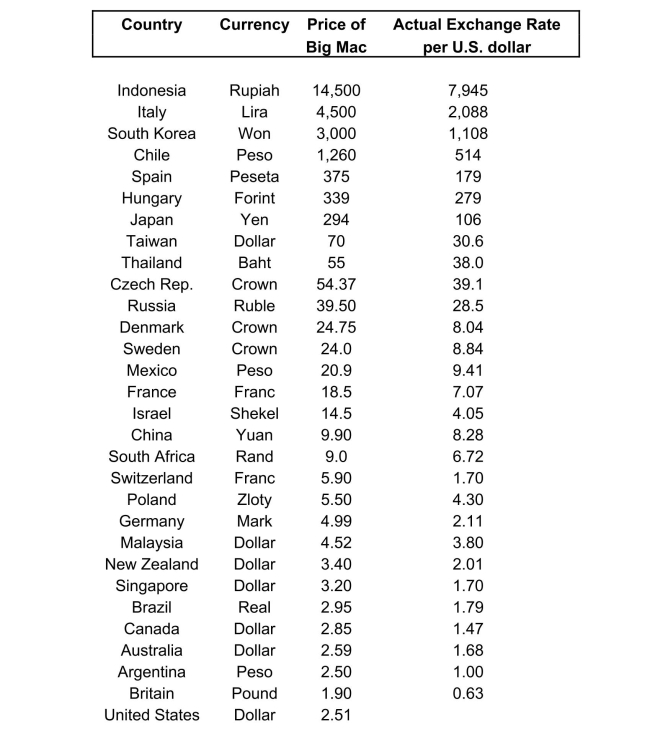(continuation with the Purchasing Power Parity question from Chapter 4)
The news-magazine The Economist regularly publishes data on the so called Big
Mac index and exchange rates between countries.The data for 30 countries from
the April 29, 2000 issue is listed below:  The concept of purchasing power parity or PPP ("the idea that similar foreign and domestic goods ... should have the same price in terms of the same currency," Abel, A. and B. Bernanke, Macroeconomics, edition, Boston: Addison Wesley, 476) suggests that the ratio of the Big Mac priced in the local currency to the U.S. dollar price should equal the exchange rate between the two countries. 16
The concept of purchasing power parity or PPP ("the idea that similar foreign and domestic goods ... should have the same price in terms of the same currency," Abel, A. and B. Bernanke, Macroeconomics, edition, Boston: Addison Wesley, 476) suggests that the ratio of the Big Mac priced in the local currency to the U.S. dollar price should equal the exchange rate between the two countries. 16
After entering the data into your spread sheet program, you calculate the predicted
exchange rate per U.S.dollar by dividing the price of a Big Mac in local currency
by the U.S.price of a Big Mac ($2.51).To test for PPP, you regress the actual
exchange rate on the predicted exchange rate.
The estimated regression is as follows: (a)Your spreadsheet program does not allow you to calculate heteroskedasticity
robust standard errors.Instead, the numbers in parenthesis are homoskedasticity
only standard errors.State the two null hypothesis under which PPP holds.Should
you use a one-tailed or two-tailed alternative hypothesis?
Definitions:
Simpler Words
The use of easy-to-understand and straightforward vocabulary to convey a message or information.
Nonverbal Responses
Nonverbal responses encompass the unspoken elements of communication such as facial expressions, gestures, posture, and tone of voice, conveying feelings and reactions without words.
Verbal Responses
Spoken replies or reactions to questions, statements, or situations in communication.
Jargon
Jargon consists of specialized terms or expressions used by a particular profession or group, often difficult for outsiders to understand.
Q1: Roughly ten percent of elementary schools in
Q3: Your textbook used the California Standardized
Q3: The binary dependent variable model is an
Q6: In the case of perfect multicollinearity,
Q7: The error term in a multiperiod regression<br>A)is
Q7: For the polynomial regression model, a.
Q22: When testing joint hypothesis, you should<br>A)use t-statistics
Q29: A VAR with five variables, 4 lags
Q38: The following does not represent a threat
Q44: The following types of statistical inference are